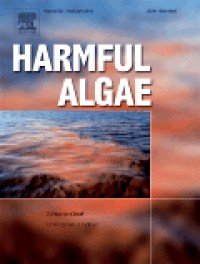Harmful Algae Q1 Unclaimed
Harmful Algae is a journal indexed in SJR in Plant Science and Aquatic Science with an H index of 119. Journal with a Single blind Peer Review review system, and It has a price of 2385 €. It has an SJR impact factor of 1,618 and it has a best quartile of Q1. It is published in English. It has an SJR impact factor of 1,618.
Type: Journal
Type of Copyright:
Languages: English
Open Access Policy: Open Choice
Type of publications:
Publication frecuency: -


2385 €
Inmediate OANPD
Embargoed OA0 €
Non OAMetrics
1,618
SJR Impact factor119
H Index126
Total Docs (Last Year)348
Total Docs (3 years)9970
Total Refs2105
Total Cites (3 years)347
Citable Docs (3 years)4.91
Cites/Doc (2 years)79.13
Ref/DocOther journals with similar parameters
Annual Review of Plant Biology Q1
Fungal Diversity Q1
Molecular Plant Q1
Nature Plants Q1
Annual Review of Phytopathology Q1
Compare this journals
Aims and Scope
Best articles by citations
Preface to the special issue on Prorocentrum minimum
View moreMass accumulation of mucilage caused by dinoflagellate polysaccharide exudates in Tasman Bay, New Zealand
View moreNitrate and phosphate uptake kinetics of the harmful diatom Eucampia zodiacus Ehrenberg, a causative organism in the bleaching of aquacultured Porphyra thalli
View morePrevention and control of Karenia brevis blooms
View morePentaplacodinium saltonense gen. et sp. nov. (Dinophyceae) and its relationship to the cyst-defined genus Operculodinium and yessotoxin-producing Protoceratium reticulatum
View moreA retrospective appraisal of the importance of high-resolution sampling for harmful algal blooms: Lessons from long-term phytoplankton monitoring at Sherkin Island, S.W. Ireland
View moreUse of molecular markers as indicators for winter zooplankton grazing on toxic benthic cyanobacteria colonies in an urban Colorado lake
View moreProrocentrum minimum (Dinophyceae) in the Baltic Sea: morphology, occurrence - a review
View moreEffects of a Prorocentrum minimum bloom on light availability for and potential impacts on submersed aquatic vegetation in upper Chesapeake Bay
View moreToxin composition variations in cultures of Alexandrium species isolated from the coastal waters of southern China
View moreParalytic shellfish poisoning surveillance in California using the Jellett Rapid PSP test
View moreToxin composition variations in cultures of Alexandrium species isolated from the coastal waters of southern China
View moreLight as a possible regulator of MIB-producing Planktothrix in source water reservoir, mechanism and in-situ verification
View moreParalytic shellfish toxin profile in strains of the dinoflagellate Gymnodinium catenatum Graham and the scallop Argopecten ventricosus G.B. Sowerby II from Bahi´a Concepcion, Gulf of California, Mexico
View moreToxin production in migrating dinoflagellates: a modelling study of PSP producing Alexandrium
View moreMolecular identification of Ostreopsis cf. ovata in filter feeders and putative predators
View moreInsights into the relationship between colony formation and extracellular polymeric substances (EPS) composition of the cyanobacterium Microcystis spp
View moreCorrigendum to "Model assessment of present-day Phaeocystis colony blooms in the Southern Bight of the North Sea (SBNS) by comparison with a reconstructed pristine situation" [Harmful Algae 37 (2014) 172-182]
View moreCharacterization and deployment of Solid Phase Adsorption Toxin Tracking (SPATT) resin for monitoring of microcystins in fresh and saltwater
View moreResponses of the estuarine copepod Pseudodiaptomus annandalei to diatom polyunsaturated aldehydes: Reproduction, survival and postembryonic development
View moreReview: a meta-analysis comparing cell-division and cell-adhesion in Microcystis colony formation
View moreDomoic acid in phytoplankton and fish in San Diego, CA, USA
View moreEctoenzymes in Prorocentrum minimum
View moreCorrigendum to "Sampling harmful benthic dinoflagellates: Comparison of artificial and natural substrate methods" [Harmful Algae 39 (2014) 8-25]
View more
Comments